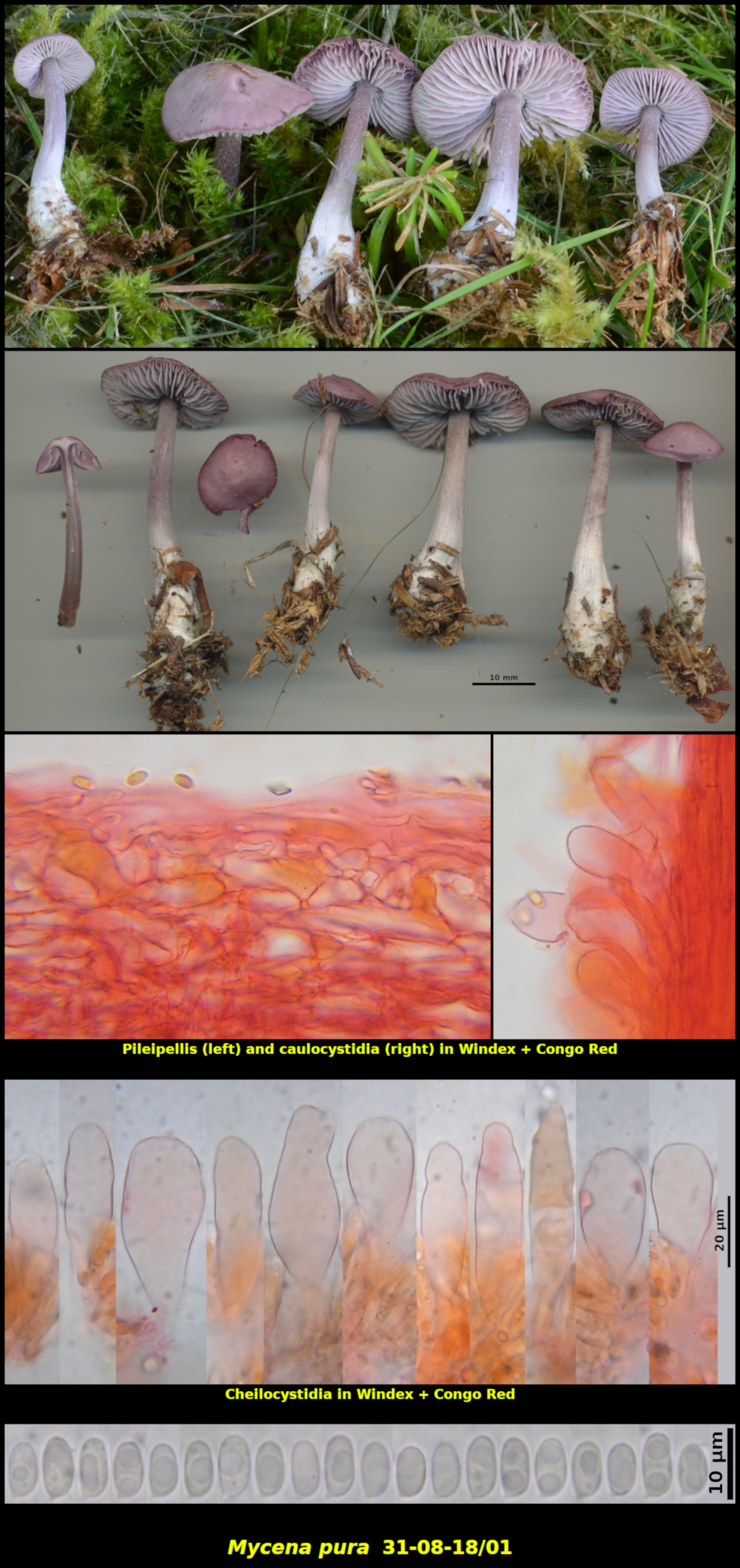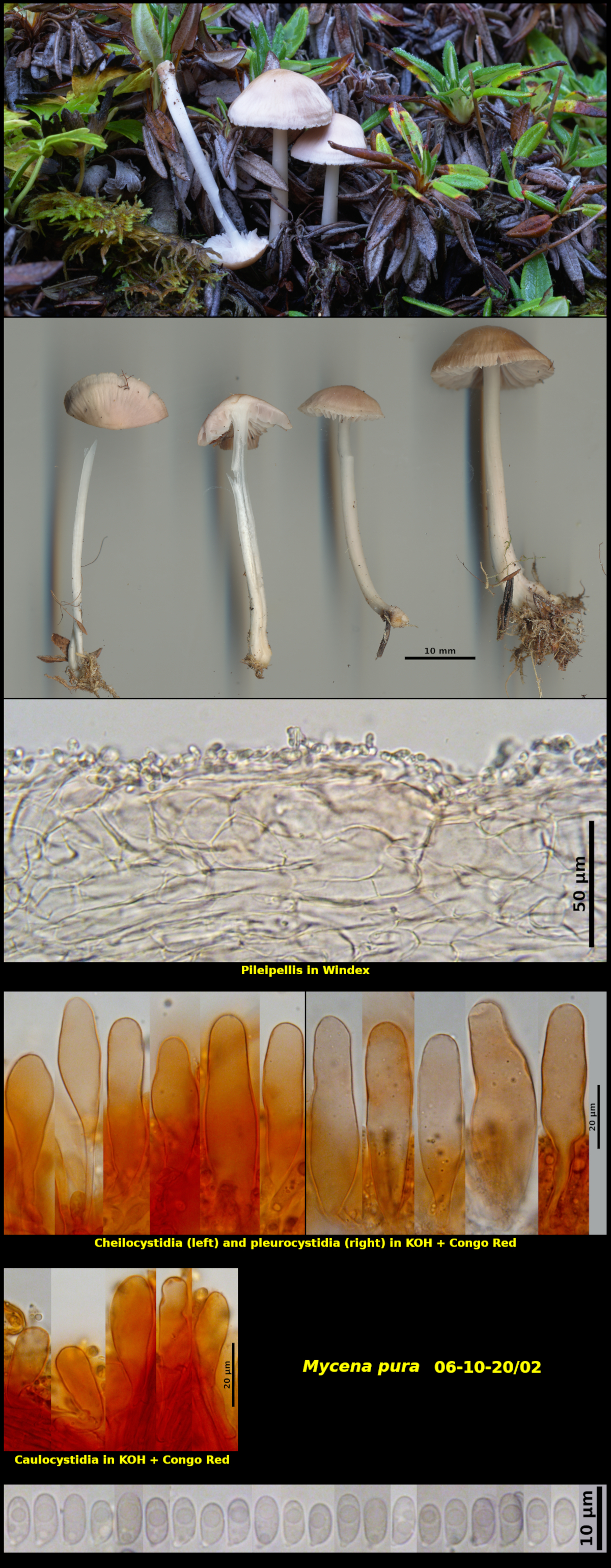Fleshy Fungi of New Brunswick >>
Mycena pura
Mycena pura (Pers.) P. Kumm.


Two collections:
-
Pileus conical at first, expanding to broadly convex at maturity, with an inconspicuous low broad umbo or with no umbo at all, dry, glabrous, purple (HSV270;10-20:80-90), 13-24 mm in diameter. Stipe clavate, white-pruinose at the apex, glabrous elsewhere, silky-shiny, concolorous with the pileus in the upper half to two-thirds, white at the swollen base, dry, 32-50 X 2-3 mm. Lamellae mostly concolorous with the pileus and stipe, white in a narrow marginal zone, close to subclose, adnexed, not marginate. Flesh concolorous with the surface tissues near the surface, white in the central parts of both pileus and stipe, with a raphanoid odour and taste.
Basidiospores white in spore print, narrowly ellipsoidal, smooth, very weakly amyloid (shown by putting Melzer’s on a pile of spores), 7.0-8.9 x 3.9-4.6 μm, Q = 1.69-2.15 (average[38]: 7.9 x 4.1 μm, Q = 1.91). Basidia borne on a very densly compact subhymenium, 4-spored, clamped at the base. Cheilocystidia scattered, voluminous, variously cylindrical to clavate or bulbous, sometimes with a slightly mucronate apex, 48-76 x 12.7-24.1 μm. Pleurocystidia scattered but not difficult to find, similar to the cheilocystidia but more consistently clavate to bulbous. Pileipellis an ixocutis of narrow and possibly finely encrusted clamped hyphae, with a subcutis of short broad interwoven hyphae. Stipitipellis a cutis, producing clusters of clavate caulocystidia similar to the cheilocystidia. -
Pileus broadly conical, slightly rugulose toward the margin, opaque and not striate, glabrous, dry, pale orange brown (HSV45:20:80-90) to pale orange grey (HSV35:05:90), 13-18 mm in diameter. Stipe equal down to the slightly enlarged base, enveloping masses of peat-like dead mosses, white, glabrous, dry, not exuding any liquid, 36-42 X 2.0-2.5 mm. Lamellae white, adnexed, subclose, not marginate. Flesh white in the pileus and stipe, with a raphanoid odour and taste.
Basidiospores white in spore print, narrowly ellipsoidal to subcylindrical, occasionally slightly dacryoid. smooth, lightly amyloid, 6.5-8.8 x 3.5-4.3 μm, Q = 1.67-2.27 (average[44]: 7.4 x 3.8 μm, Q = 1.96). Cheilocystidia scattered along the edges of the lamellae, often produced in small clusters, clavate to narrowly ventricose, thin-walled, without ornamentation, with a basal clamp connection, about 54-78 x 11-17 μm. Pleurocystidia numerous, scattered on the sides of the lamellae, similar to the cheilocystidia although less often clavate, with a basal clamp connection, about 58-82 x 13-21 μm. Caulocystidia abundant near the apex of the stipe, clavate, with a basal clamp connection, about 40-56 x 10-13 μm. Basidia clavate 4-spored, with a basal clamp connection. Pileipellis a thin cutis, produced above a subpellis of short broad hyphae.
1. Gregarious (7) amongst grasses and gametophytes of Rhytidiadelphus sp. in a rural lawn, associated with Abies balsamea, Little Lepreau, New Brunswick (31-08-18/01).
2. Clustered (3) among gametophytes of Rhytidiadelphus sp. in a mat of Dryas integrifolia on a gypsum talus slope, Wilson Brook Protected Natural Area, New Brunswick (06-10-20/02).
As illustrated by the two collections shown here, M. pura is a highly variable species. In fact, various authors, both North American and European, have pointed out that there are probably several species hiding under this name. Molecular studies, combined with morphology, will undoubtedly clarify this issue, but for now we find ourselves unable to do more than follow the old concepts.
The best guide for this and other species of Mycena in North America is the monograph by Alexander H. Smith (North American Species of Mycena, Univ. Mich. Press, 1947), a voluminous work meticulously documenting the morphology and taxonomy of this large genus. He discussed M. pura at some length, describing its great variabililty, but finally admitting that he could find no reliable basis for subdivding it.
Typically, the two collections presented here are somewhat at odds with Smith's description and from each other. Collection 06-10-20/02 has a very fragile stipe and basidiospores narrower than those described by Smith, while Collection 31-08-18/01 has a more robust and strongly coloured stipe and basidiospores broader than those described by Smith. The habitats for the two collections are also quite different.
Photograph: D. Malloch (31-08-18/01, 06-10-20/02).